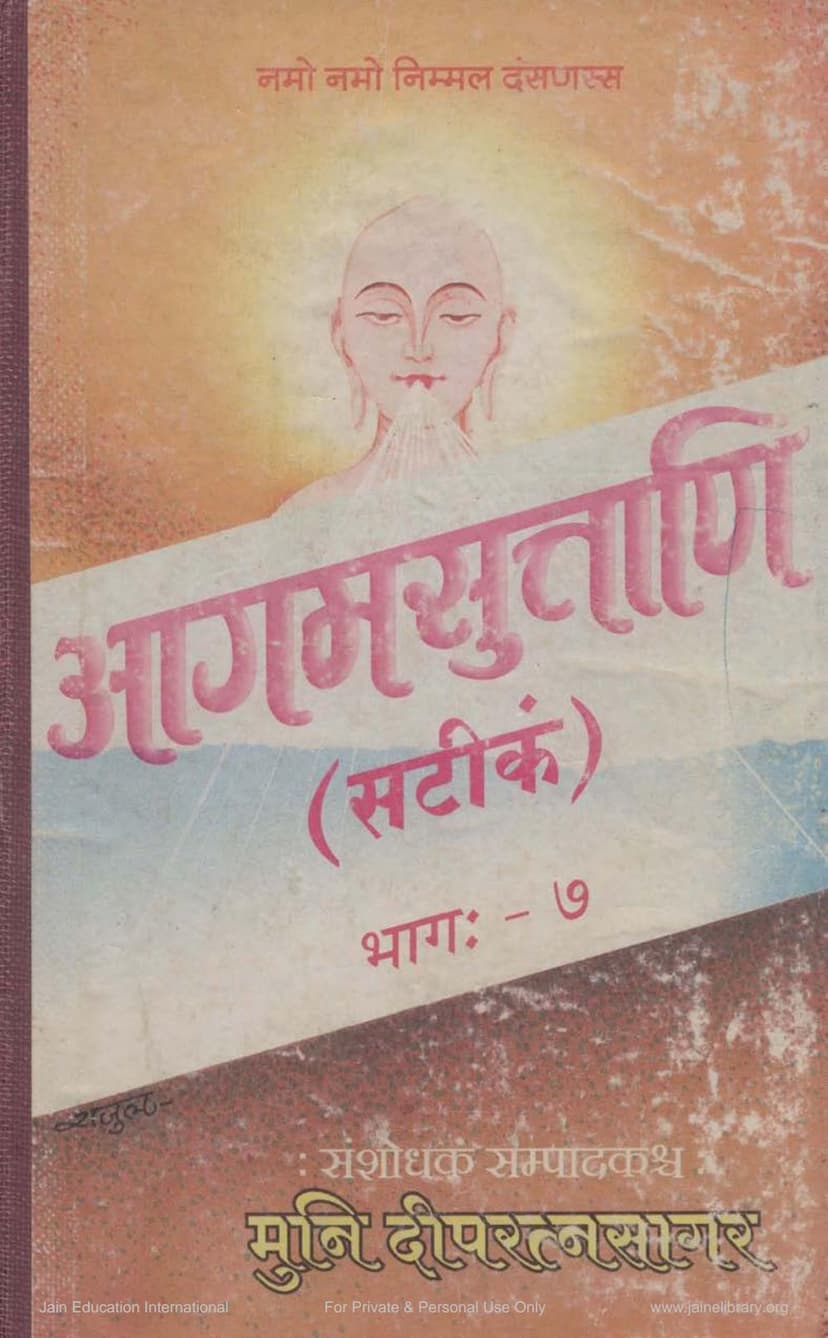Agam Sutra Satik 10 Prashnavyakarana AngSutra 10
Added to library: September 1, 2025

Summary
This Jain text, "Agam Sutra Satik 10 Prashnavyakarana AngSutra 10" by authors Dipratnasagar and Deepratnasagar, published by Agam Shrut Prakashan, is a comprehensive annotated edition of several key Jain Agamas, primarily focusing on the "Prashnavyakarana Anga Sutra."
The book is part of a larger series titled "Agam Suttani (Satik)" and is specifically Volume 7. It begins with devotional salutations to the Tirthankaras and respected gurus, setting a spiritual tone.
Key Agamas Included:
The table of contents clearly outlines the inclusion of five major Angas (limbs or sections) of the Jain canon:
- Jnātādharmakathāṅga Sūtra: This section deals with narratives and teachings related to dharma. The table of contents shows it covers 19 studies (adhyayana) within its first section (Shrutaskandha) and further categorized into various "vargas" (classes or sections) within the second Shrutaskandha, detailing specific subjects.
- Upāsakadashāṅga Sūtra: This text focuses on the ten stages or experiences of lay followers (upasakas). The table of contents lists its content across several vargas, indicating detailed discussions on various aspects.
- Antakṛddashāṅga Sūtra: This Agama deals with the ultimate or end states. Its content is also broken down into vargas and studies.
- Anuttaraupapātikadaśāṅga Sūtra: This text likely discusses beings in the highest heavens or transcending states. Its table of contents shows it is organized into vargas and studies.
- Praśnavyākaraṇaṅga Sūtra: This is the primary focus of this particular volume, as indicated by the title. It deals with the "vyakarana" (explanation or grammar) of "prashna" (questions), likely referring to philosophical and ethical inquiries. The table of contents details its structure into different "dwaras" (gates or sections), such as Ashrava Dwara (gate of influx) and Samvara Dwara (gate of restraint), with further divisions into studies (adhyayana).
Structure and Content:
The provided pages highlight the extensive structure of these Agamas. The table of contents for each Sūtra is presented in detail, listing:
- Shrutaskandha (Scriptural Compilation/Section): The major divisions within each Sūtra.
- Adhyayana (Study/Chapter): The subdivisions within the Shrutaskandhas.
- Varga (Class/Category): Further thematic divisions within the Adhyayanas, often categorized by figures, concepts, or stages.
- Mūlaṅka (Root Number/Identifier): A system of numbering for referencing specific parts of the text.
- Pr̥ṣṭhāṅka (Page Number): The page where the topic begins.
The Praśnavyākaraṇaṅga Sūtra (specifically from page 8 onwards):
The text delves into the Praśnavyākaraṇaṅga Sūtra, starting with the concept of Ashrava Dwara (Gate of Influx), specifically the study on Prāṇavadha (Violence/Killing). This section begins with the foundational invocation and sets the stage for the detailed explanation of Jain principles, including the enumeration of the five primary vows (Ahimsa, Satya, Asteya, Brahmacharya, Aparigraha) and their intricate meanings. The commentary (Vr̥tti by Abhayadev Suri) provides philosophical and linguistic explanations, tracing the lineage of the teachings back to Lord Mahavira and his disciples. The text then proceeds to discuss the various forms of violence and their consequences, followed by other aspects of Ashrava like falsehood (Mṛṣāvāda), stealing (Adattādāna), and impurity (Abrahmā).
Key Themes and Concepts:
- Ashrava (Influx of Karmas): The text meticulously details the various ways karmic matter enters the soul, stemming from actions, speech, and thoughts related to violence, falsehood, stealing, impurity, and possession.
- Samvara (Restraint): The opposite of Ashrava, Samvara involves ceasing the influx of new karmas through ethical conduct, discipline, and spiritual practices. The text introduces Samvara Dwara and begins with Ahimsa (non-violence) as the first and most crucial aspect of restraint.
- The Five Great Vows (Mahavratas): These fundamental Jain vows are explored in detail, starting with Ahimsa.
- Commentary (Vr̥tti): The commentary by Abhayadev Suri is integral to the text, providing in-depth explanations, etymological derivations, and philosophical reasoning, linking the teachings to the core Jain principles and the authority of the Tirthankaras.
- Ethical and Philosophical Inquiry: The "Prashnavyakarana" aspect suggests a focus on deep questioning and resolution of complex ethical and philosophical dilemmas within the Jain framework.
Overall Purpose:
The book aims to provide a scholarly and spiritually rich annotated version of these foundational Jain scriptures, making them accessible for study and understanding of Jain philosophy, ethics, and practice. The emphasis on detailed explanations and classifications suggests a pedagogical approach to preserving and disseminating this sacred knowledge.